How to Choose a Good Cookware Set?
How to choose good cookware set for your home is not an easy task. Are you planning to install new cooking equipment in your kitchen? How do you know which pans and pots are essential? The variety of pots and pans is enormous, with materials ranging from stainless steel, aluminum, cast iron, and copper, and the number of cookware brands appears to be increasing daily.
When choosing which pots and pans to purchase, there are a few characteristics to look for, even though most of them look similar. Here, I’ll review the fundamentals of buying cookware and determine which materials will work the best for your budget and requirements.
What to Look for When Purchasing Cookware
Budget
When it comes to pricing, the best thing you can do is stick to your budget. But quality should always be a priority when choosing a good cookware set. Waiting to splurge on a top-of-the-line kitchenware set may not be in your best interest if you have a tight budget.
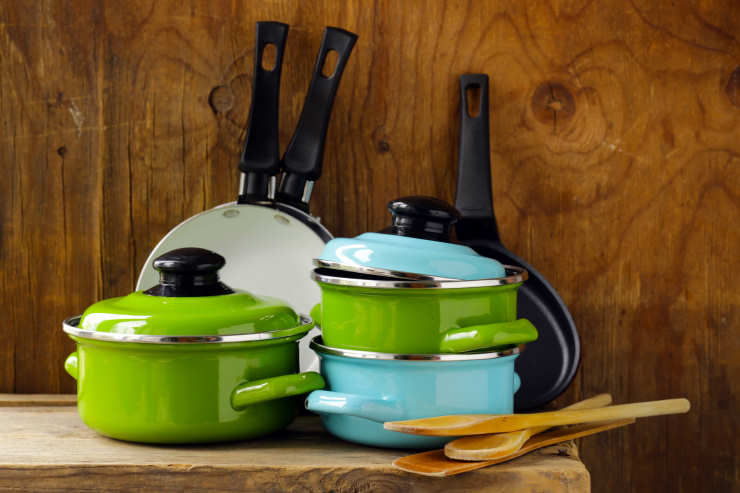
Let’s face it: if you go straight to a professional-chef-quality cookware set, the price tag can easily exceed a thousand dollars. However, buying expensive pans is not necessary. A more expensive set of pots and pans will typically last longer than a less expensive one if you treat them well.
If you take good care of a high-quality pot or pan, you might find that it saves you money over time. This does not imply that you should always invest in the most expensive cookware. Your selection criteria must be very flexible if you have a small budget. The good news is that there are many options available right now.
In addition, if you cook primarily at home on a more casual basis, a smaller set or even a single pan could be the perfect answer to your financial dilemma. You should also check to see if anything is regularly on sale in stores or online.
Material
Now that you know the kitchen accessories you require, you can begin evaluating the cookware materials. Most of the time, the cooking pot’s quality is defined by the material used to make it. The best pots are constructed from either heavy-gauge stainless steel or cookware with a hard anodized surface. Each material has advantages and disadvantages, as you will read more about in this guide on how to choose a good cookware set.
Cookware made of thick stainless steel is common in homes, but you should ensure the pot you select is made of heavy steel and has a substantial aluminum core. After reading about the advantages and disadvantages of each type of cookware, hopefully, you’ll be better able to decide which will suit your needs the most.
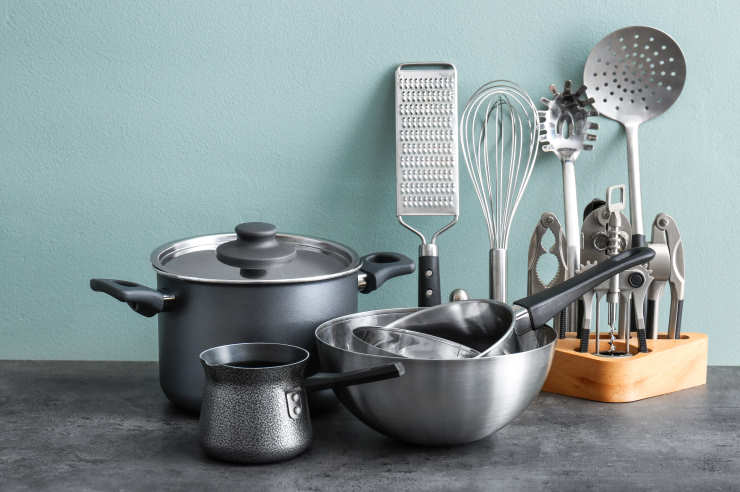
Cooking at high temperatures is typically used to brown food or add color. This would entail searing seafood or meat. It’s advised to use stainless steel pots if you frequently cook those kinds of foods. You cook directly in a pot or pan when you cook at a low temperature without adding color. Consider sautéing leafy greens or caramelizing onions. The nonstick cookware is what you should use at that time.
Stainless Steel
The most typical kind of cookware material would have to be stainless steel. This type of cookware is a traditional option. Due to its widespread availability and low cost, stainless steel is frequently used to make cookware, making it an excellent choice for beginners. It is probably present in the majority of homes.
This substance is long-lasting. Browning and braising are good uses for durable, traditional, uncoated stainless steel. Stainless steel is a metal alloy made up of carbon, steel, and chromium. Because of its corrosion resistance, stainless steel has that name.
Although stainless steel is an excellent material for cookware, it is crucial to pick stainless steel cookware with an aluminum or copper core due to the material’s poor ability to conduct heat. Without it, you will experience uneven food cooking.
| Pros | Cons |
| Easy to maintain | Cleaning can be more difficult at times |
| Provides quick, uniform heating | Not a good heat conductor |
| Durable | |
| Reasonably priced | |
| Warp resistance | |
| Scratch and dent resistant | |
| It keeps its gleaming appearance for a long time | |
| Doesn’t react to foods that you are cooking |
Copper
Professional chefs frequently use copper cookware due to its excellent conduction of heat. Cookware made of real copper cooks quickly and evenly and cools down quickly for maximum control. This gives you more power over your cooking.
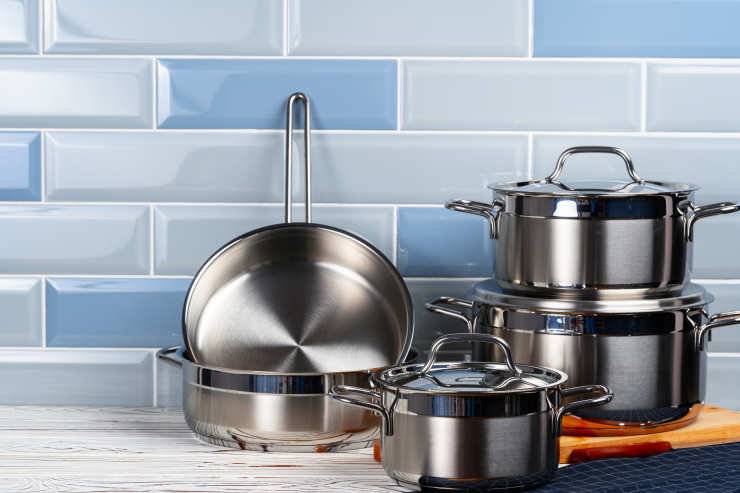
Since copper cookware is typically expensive, it is not frequently found in home kitchens. However, because of its excellent heat conductivity, ease of cleaning, and stunning aesthetics, copper can be quite pricey, but for a good reason. Additionally, stainless steel or other materials are frequently found between layers of copper.
| Pros | Cons |
| Superior heat conduction | Dents easily |
| The ideal material for chefs | Quite pricey |
| Beautiful design | It needs to be polished frequently |
| Reacts to acidic foods | |
| Hand washing only |
Cast Iron
Cookware has been made from cast iron for centuries. Cast iron can withstand high heat, keeping the oil hot enough to deep-fry chicken while searing steaks. Due to their exceptional durability, cast iron pots and pans that have been handed down through the generations are frequently found. While this heavy material requires a lot of maintenance, it is an unbeatable option for cooking meats like burgers and steaks.
| Pros | Cons |
| Reasonably priced | Unless seasoned, it reacts to food |
| Extremely long-lasting | Special care is required, and regular seasoning is necessary |
| Naturally nonstick | It is heavier than most other cookware types |
Aluminum
This material is also widely accessible and frequently found in cookware sets and other materials, like stainless steel cookware with aluminum cores. It can also react with some foods, which is why other metals are typically sandwiched between them. Anodization is a common method of treatment for aluminum.
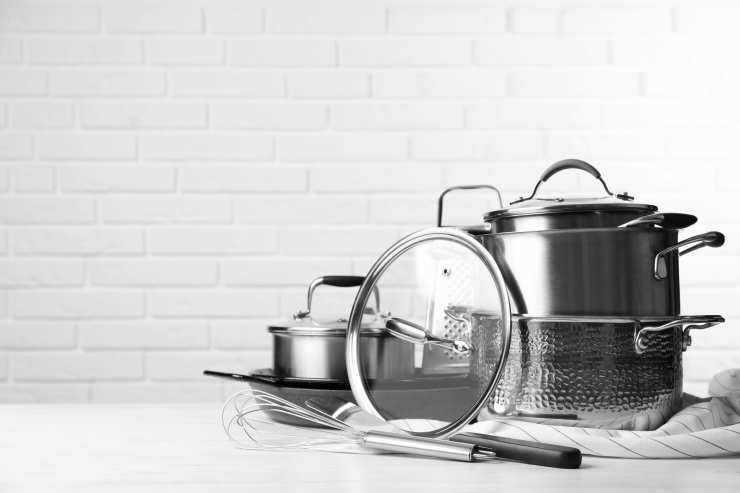
Aluminum oxide is applied as a layer during this process, making the surface resistant to scratches and guaranteeing that food won’t react with it. In addition, nonstick coatings are frequently applied to aluminum cookware to prevent food from being burned.
| Pros | Cons |
| High-quality heat conduction | Reacts to acidic food |
| Lightweight | Easily dents and scratches |
| Reasonably priced |
Heat Conductivity
Different metals have different thermal conductivities. For example, the pots and pans without an aluminum core are made of stainless steel or copper, which are excellent heat conductors. Regarding cookware, the better the heat conductivity, the more evenly your food will cook. Additionally, copper cookware will respond to temperature changes much quicker than stainless steel cookware when you adjust the heat higher or lower.
Aluminum cooking pans should be your first choice if you require a pan with excellent heat conductivity. Unfortunately, despite being extremely affordable, these can rust and alter the flavor of cooked food because they are extremely sensitive to acidic foods.
Since acidic or alkaline foods can corrode aluminum pots and pans, it may be best to avoid using them when cooking foods with high acidity. This may lead to the contamination of your food with undesirable chemicals like aluminum. Look for aluminum pans with an anodized or stainless-steel coating if you want to avoid these drawbacks.
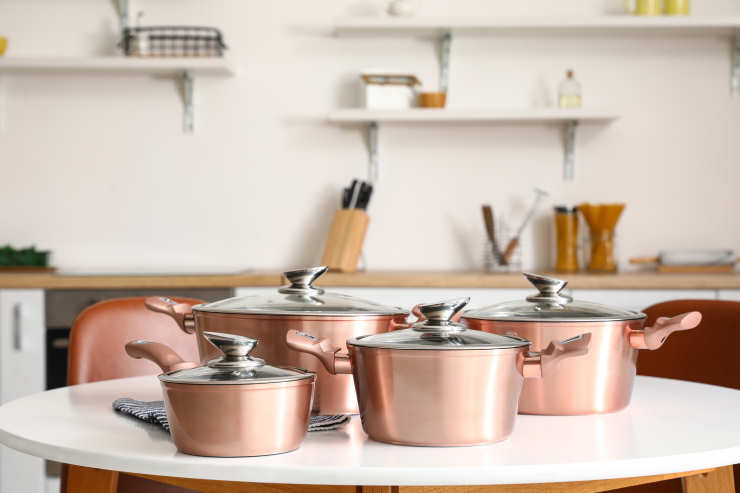
These pans don’t need any special maintenance; they need to be cleaned occasionally. It is sufficient to wash them in soapy water. However, if you have an anodized aluminum pan, take care not to scratch the coating by washing it in the dishwasher. However, you should be aware that a thicker layer of material might result in a longer heating time for your pot or pan. Therefore, when choosing a thickness, it’s critical to strike a balance.
Lids and Handles
When looking for how to choose a good cookware set, lids are frequently neglected. Instead, a tight-fitting pair is what you should always seek out. When your cooking pot or pan has a tight-fitting, break-resistant lid that keeps and evenly distributes all heat and moisture inside the cookware, you can cook easily.
Make sure the lids on the cookware you purchase are high quality so that cooking will be more straightforward. Consider the lids’ materials as well. With a glass lid, you can see what’s happening inside your pot without lifting it off and letting the steam out. However, they add weight and tend to break, which could be problematic in a home with young children.
Different materials are used for the handles on some pots and pans. You should consider whether the lids are oven safe, just like the handles. You can cook with a tightly fitting stainless steel lid in your oven. It should have a secure attachment and a cool-to-the-touch molded handle that is comfortable to hold while cooking. Lifting heavier pans is made easier by an additional support handle. If you want to avoid burning your hands while draining, go with the special cold grips. In this manner, a potholder is no longer necessary.

Aesthetic
When searching how to choose a good cookware set, aesthetics is another factor you should consider. Cookware can and ought to be a decorative element in the kitchen. The cookware’s colors should match or complement your sophisticated kitchen interior décor. Make sure that the design and color of your cookware enhance the appearance of your kitchen and gives it new dimensions.
Maintenance
You must consider the maintenance needed to keep your cookware in top condition if you prefer not to have to shine it every night to keep it looking good. Most cookware comes with care instructions, so be sure to follow them. Typically, it is best to use soapy water and a damp sponge to wash the bakeware.
Stainless steel is typically a little easier to maintain than copper or cast-iron cookware, which generally requires more effort to keep it looking pristine. Here are some suggestions to extend the life and preserve the appearance of your cookware:
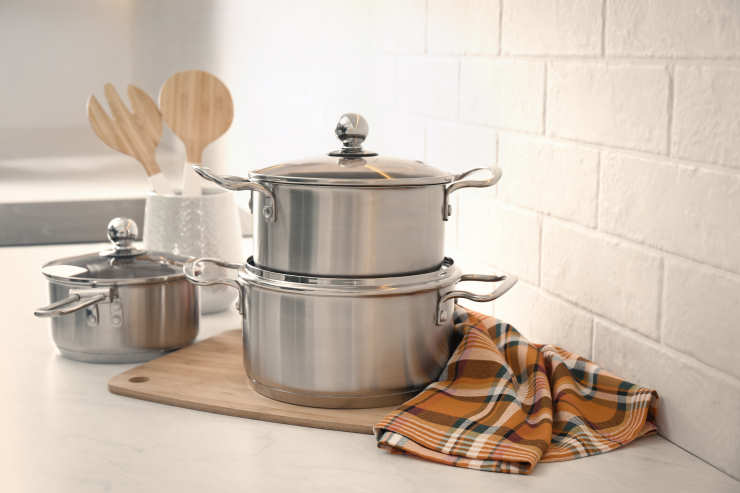
- A hot pan should never be submerged in or filled with cold water. Always wait until a pan has cooled before giving it a hot, soapy wash.
- Metal kitchen tools should be avoided because they can scratch your cookware. Use silicone or wood instead.
- You must never leave an empty pan in a heated oven or hot burner.
- Cast iron cookware should not be used to prepare acidic foods. This is because the metal can be eaten away by the acid.
- When cleaning nonstick cookware, exercise extra caution and avoid scouring pads, steel wool, and other abrasives.
- To prevent chipping the porcelain, use coated cookware with care.
- Before putting pans and lids away, ensure they are completely dry because standing water can collect and begin to smell. Similarly, wet pans may start to rust.
- Coated cookware shouldn’t be stacked on top of one another. Scratching and chipping can be avoided by storing them differently.
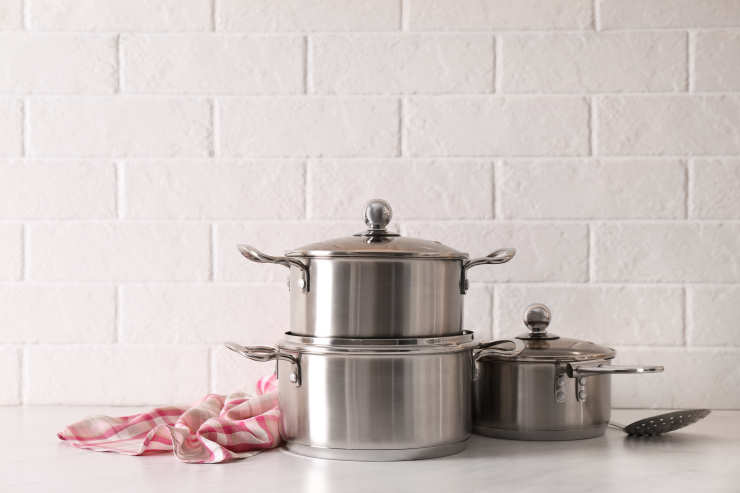
Conclusion
It comes down to personal preference, depending on how much time you spend cooking, how skilled you are in the kitchen, and your budget, whether you want cast iron, stainless steel, copper, or aluminum. Stainless steel cookware would rank first for overall flexibility, usability, and cost. Finding the best cooking pan for your needs is simple if you base your search on these criteria.
Although the majority of cookware sets will set you back a small fortune, you might never need to buy more. By doing this, you’ll invest wisely, get a return on your investment over time, and greatly enhance your enjoyment of cooking.
There are a few crucial factors to consider whether you need to buy a good starter set or are looking to expand your cookware collection. You’ll be happily cooking in your new pans and pots in no time, though, if you heed this thorough guide’s advice on choosing a good cookware set.
Suppose you take your time selecting cookware, invest in the best model in your budget, and follow the manufacturer’s care instructions. In that case, you’ll be rewarded with years of reliable service and a pleasurable cooking experience. Happy cooking, everyone!

